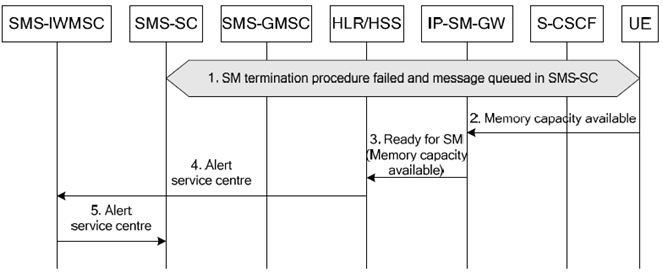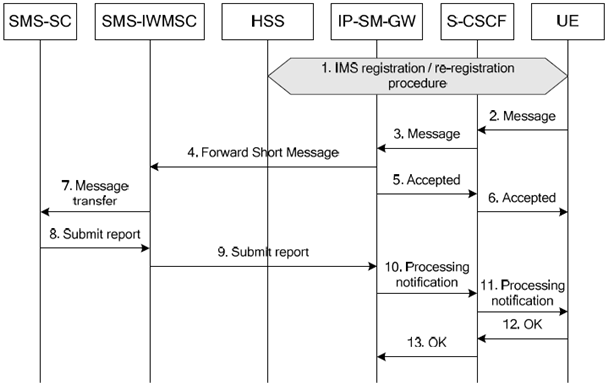Content for TS 23.204 Word version: 19.1.0
6.6 Transport-level interworking: Alert service centre procedure when memory capacity is available
6.7 Service-level Interworking: IM or CPM capable UE sends an Instant Message to an SMS user
...
...
6.6 Transport-level interworking: Alert service centre procedure when memory capacity is available p. 28
If the HLR/HSS has recorded the MWD with a failure reason that the message failed to be sent by IP-SM-GW due to the memory capacity of the UE is exceeded, once the HLR/HSS receives a message from any of the domain indicating that the memory capacity of the UE is available again, e.g. form the IMS, PS or CS domain, the HLR/HSS initiates a Alert service centre procedure to request the SMSC to re-send the stored message.
The following Figure only shows an example where the HLR/HSS invokes the Alert service centre procedure when the memory capacity available message is received from IMS.

Figure 6.6: Alert service centre procedure when memory capacity is available
(⇒ copy of original 3GPP image)
(⇒ copy of original 3GPP image)
Step 1.
If SM termination attempts (via IP-SM-GW) failed because the UE's Memory Capacity Exceeded, the message to be transferred to IP Based UE is queued in the SMS-SC.
Step 2.
UE sends a message to IP-SM-GW indicating that the UE has memory available to receive one or more Short Messages.
Step 3.
IP-SM-GW notifies the HLR/HSS of memory being available in the UE.
Step 4.
If the HLR/HSS receives the indication that the UE has memory available to receive one or more Short Messages, it initiates a Alert service centre procedure with the SC address and the MSIsdn-Alert to SMS-IWMSC as described in TS 23.040.
Step 5.
The SMS-IWMSC forwards the Alert service centre message to the SMS-SC whose address was provided by the HLR/HSS in step 4.
6.7 Service-level Interworking: IM or CPM capable UE sends an Instant Message to an SMS user |R8| p. 29

Step 1.
The UE registers to S-CSCF according the IMS registration procedure.
Step 2.
UE submits the Instant Message to the S-CSCF using an appropriate SIP method. The UE may request to hide its Public User Identity from the recipient within the Instant Message, as described in OMA-TS-SIMPLE_IM-V1_0 [12] or in OMA-TS-CPM_Conv_Fnct-V1_0 [17]. If the P-CSCF (not shown in the figure) has received an indication from the S-CSCF that MPS for Messaging is set (enabled) for the UE in the HSS (see TS 23.228), the P-CSCF sets the Resource-Priority information on the Instant Message to a value appropriate for MPS, sets the transport priority of the Instant Message to a value appropriate for MPS and handles the Instant Message with priority.
Step 3.
S-CSCF forwards the Instant Message to IP-SM-GW based on stored iFC.
Step 4.
The IP-SM-GW shall decide whether to perform service-level interworking depending on SIP request header (e.g. Request-URI), operator policy, when the Instant Message is not routable in the IMS. If an ISF is deployed in the network, the ISF may take the decision to interwork using SMS and sends the message to the IP-SM-GW to perform the interworking. If IP-SM-GW decided to perform service-level interworking, the IP-SM-GW performs service authorization based on the stored subscriber data retrieved from the HLR/HSS at the time of the registration procedure as specified in clause 6.1. The IP-SM-GW shall check whether the originating subscriber is authorised to use the interworking service. If the result of service authorization is negative, the IP-SM-GW shall not forward the message, and shall return the appropriate error information to the UE in a failure report. Otherwise, the IP-SM-GW shall use the SC Address in the subscriber data retrieved from the HSS at registration or provisioned by configuration and translates the Instant Message to a Short Message (SMS- SUBMIT) carrying SC Address, then forwards it towards SMS-SC (SC Address) via the SMS-IWMSC (as described in TS 23.040). If the size of the content of the Instant Message is larger than the size of the content that one Short Message could transfer, the IP-SM-GW shall split the content of the Instant Message into several parts, translate them to concatenated Short Messages, and forward the concatenated Short Messages to the SMS-SC as described in TS 23.040. If the sender of the Instant Message requests to hide its Public User Identity from the recipient and operator policy allows for this, the IP-SM-GW shall anonymize the identity of the user to the recipient. Otherwise, if operator policy prohibits this, the IP-SM-GW shall return an appropriate error to the user.
If the Resource-Priority information on the Instant Message has a value appropriate for MPS, the IP-SM-GW sets the transport priority of the outgoing Short Message to a value appropriate for MPS and handles the Short Message with priority.
Step 5.
If service authorization is successful, the IP-SM-GW acknowledges the Instant Message.
Step 6.
Instant Message acknowledgement is forwarded by S-CSCF to UE.
Step 7.
The SMS-IWMSC forwards the Short Message (SMS- SUBMIT) to the SMS-SC (see TS 23.040).
Step 8.
The SMS-SC sends a Submit report (SMS-SUBMIT REPORT) to the SMS-IWMSC (see TS 23.040).
Step 9.
SMS-IWMSC sends a Submit report to IP-SM-GW (see TS 23.040).
Step 10.
IP-SM-GW translates the received Submit report to an appropriate Instant Message, and forwards it to the S-CSCF. If the IP-SM-GW sent concatenated Short Messages to SMS-SC in step 4, the IP-SM-GW should wait for the last Submit report, and translate the last Submit report to an appropriate Instant Message, and forward it to the S-CSCF.
Step 11.
S-CSCF sends the translated Instant Message to the UE.
Step 12.
UE acknowledges the translated Instant Message.
Step 13.
Acknowledgement of the translated Instant Message is forwarded by S-CSCF to IP-SM-GW.